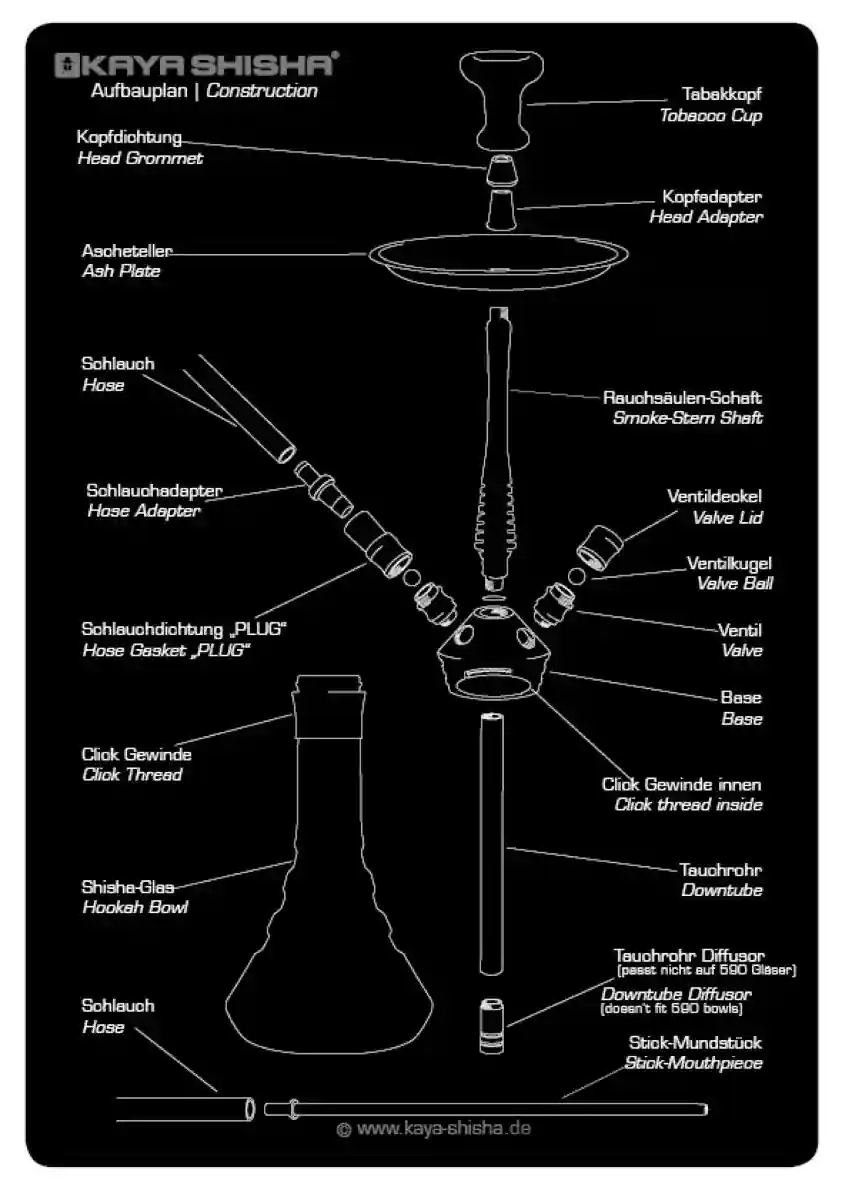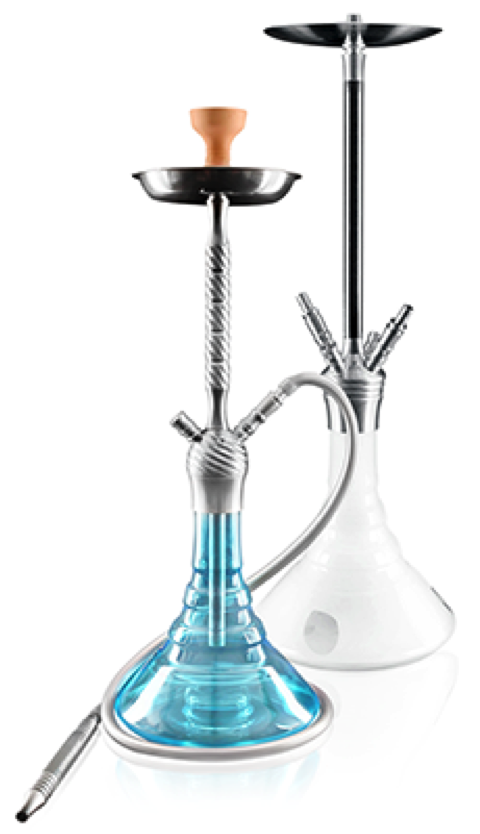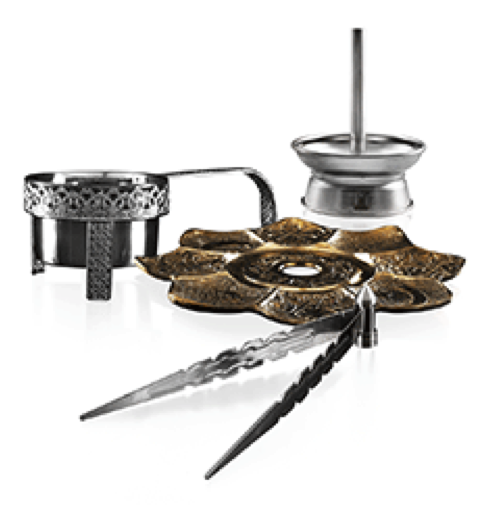
I am at least 18 years old
Please confirm by clicking in the checkbox that you are 18+ in order to be allowed to use our shop.
Then please end this POP-UP with the "Close-Cross" in the upper right corner.
What are the parts that make up a hookah? And how do you have to assemble these parts to get a functioning hookah? Maybe you have asked yourself this question before. Especially if you are just starting to get to know the pleasure of hookah smoking. To help you get started in the world of hookahs, we have compiled the most important facts about hookah smoking.

Put the hookah glass aside. Assemble the remaining parts. Fill the glass container with water. How much water you need depends on the shape and size of the bowl. The water level should only be high enough for the immersion tube to reach 2-3cm into the water. If the level is too high, the resistance may become too extreme or water may be drawn up into the hose when smoking.
Put the the remaining hookah parts together and assemble the hookah by connecting the base to the water-filled hookah glass. Depending on the thread type, the glass is either screwed, clicked or plugged into the smoke column.
Fill the tobacco bowl about 2/3 full with hookah tobacco. The tobacco should lie loosely in the tobacco bowl. If the tobacco is too compressed, pull it apart slightly beforehand. It should not be pressed or compressed so that the hot air can pass through it best.
Continue preparing the tobacco bowl by placing a chimney or heat manager on it. If used with a chimney, it should be lightly pressed on to prevent it from sliding off. If you are building the tobacco bowl with aluminium foil, stretch it tightly over the rim area. Hold the foil-covered bowl in one hand and pierce holes all around the foil with a foil punch or similar tool.
Quick lighting coal is only suitable for use with aluminium foil and chimneys. With this coal, all you need to do is hold the cubes with tongs and light them with a lighter or jet burner. Blow on the coal pieces to get the coal to glow. Only put it on the tobacco bowl when it is completely glowing.
For natural charcoal, you need an electric lighter. Place the charcoal cubes on the grill grate or directly on the heating coil. Leave them on the lighter for between 10-15 minutes, depending on the size of the cubes. It is advisable to turn the cubes occasionally until they are completely glowing.
Opinions on what is and is not necessary as initial hookah smoking equipment vary a little - depending on who you ask. However, there are a few basic things without which getting started smoking hookahs cannot succeed.
A solid hookah is the heart of your first session. When buying one, pay attention to whether it comes with or without accessories. Basic models usually only include a fraction of the necessary parts. To be able to start smoking straight away, the hookah should come with the following parts:

Choose a type of tobacco with an aroma that suits your taste. Hookah tobacco already has the necessary moisture to be smoked in a hookah. If it is a little dry, you can moisten it with some molasses or glycerine. If the tobacco is too dry, the taste and smoke production can be affected. If you prefer to smoke nicotine-free, you can also use vapour pastes or vapour stones.
You can prepare a tobacco bowl in different ways with the appropriate bowl accessories: When building with foil, you stretch aluminium foil over the bowl filled with tobacco and then poke holes in the foil. You then place the glowing hookah charcoal on the foil. It is often difficult for beginners to distribute the heat evenly to the tobacco. It is easier with a chimney attachment or a heat manager. These are simply placed on the filled tobacco bowl and loaded with glowing charcoal. Smoke production starts after a short time.
You have the choice between natural charcoal and quick lighting charcoal. We recommend the use of natural charcoal made from coconut shells. It burns longer, hotter and does not develop an unpleasant aftertaste, so that the aroma of the tobacco can fully develop.
Because hookah charcoal has to be put on while it is glowing hot, you need a charcoal lighter when using natural charcoal. The charcoal must first glow on the heating plate, heating coil or grill grate.
Of course, you cannot touch the hot pieces of charcoal with your fingers to place them on the foil. Therefore, the use of coal tongs is indispensable.

A fireproof metal charcoal basket is needed for preheating, transporting and depositing the glowing hot pieces of charcoal.
At some point, your smoking session will be over and you will need to clean your hookah. Clean it thoroughly by taking it apart completely. An elongated, thin brush that fits into the immersion tube and shaft will remove tobacco and molasses residue. Clean everything with lukewarm water in which you have dissolved a Corega tab, for example, and rinse the pipe thoroughly. If you want to clean it especially in-depth, get special hookah cleaner such as "TipTop" by Kaya Shisha.
If you don't feel like searching for the right items, check out our complete hookah sets. With the exception of tobacco or tobacco substitute, these include everything you need to smoke hookah.
In the long history of hookah, which spans different parts of the world, a smoking culture has developed over time in which fixed rules have emerged. These rules are not observed by many smokers, but they are nevertheless interesting simply because of their tradition.
In the heyday of hookah, one could even be excluded from society if certain rules were not observed. Perhaps you should follow these rules with your friends to experience an even more relaxed hookah session.
Smoking alone is not forbidden, but originally hookah smoking is a social occasion and a sign of hospitality.
This is a custom that has developed over time. In Egypt or Arabia, you will almost never discover a hookah standing on a table.
If you do, this could be seen as contempt for the others and thus lead to an uncomfortable atmosphere.
On the one hand, this distorts the smell and taste of the hookah, also for the others, and on the other hand, it is a sign of impatience.
Loud talking and hectic movements disturb the peace and destroy the cosy atmosphere.
Instead, it should be hung on the hookah or placed on the table in such a way that the next person can pick it up at any time, but does not have to feel pressured to smoke.
*The section is a loosely translated modified text excerpt from the book "Die Wasserpfeife - Tradition und Jugendkultur" by Felix B.